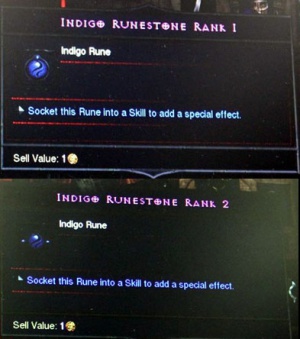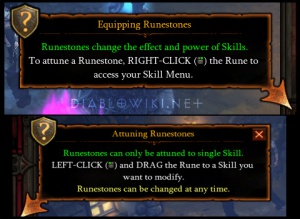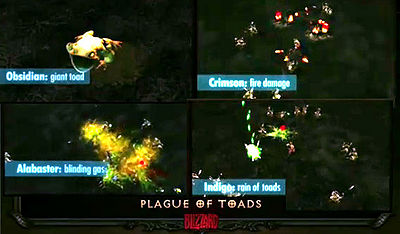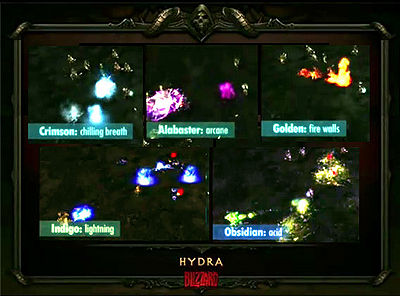Skill Runes
Runestones are small items that can be socketed - one each - into any skill, but not into traits or into items, as were runes in Diablo II. Diablo III's skill runes grant special bonuses to the skills with which they are used, altering their effects and generally enhancing them, although the changes that a rune makes to a skill may dramatically alter its utility.
- See all news related to runestones in Diablo III.
- Rune Archive -- Runes evolved greatly during the development of Diablo III. See the archive page for a history lesson.
Contents
- 1 Rune Basics
- 2 Earlier Rune Development
- 2.1 Runestone Functions
- 2.2 Basics (Old Version)
- 2.3 Rune Tool Tips
- 2.4 Proposed Changes to Rune Functionality
- 2.5 Early Functions
- 2.6 Higher-Level Runestone Functions
- 2.7 Runestone Scarcity
- 2.8 Rune Crafting/Upgrading
- 2.9 Easy Socketing
- 2.10 Confirmed Runestone Examples
- 2.11 Plague of Toads
- 2.12 Poison Dart
- 2.13 Hydra
- 2.14 Throw Weapon
- 3 Skill Rune Videos
- 4 Media
- 5 References
Rune Basics
The runes changed drastically after the Beta Patch 13, where players were first able to try them out for themselves[1].
Runes are a component of the skill system that allows a player to alter a skill, whether that alteration is major or minor. Some runes, such as the Bash rune Unleashed, won't change the basic functionality of the skill, and offer a bonus such as increased resource generation, or increased damage. However, other runes can drastically change the way a skill operates, such as the Witch Doctor's Rain of Toads rune for Plague of Toads, which instead of having a few frogs hop across the ground in an erratic pattern, the frogs then fall from the sky in a directed assault.
The runes, currently, do not have individual names, so this makes communication to other players as to rune choice highly muddled and confusing.
Attaining Runes
Runes are automatically unlocked upon a pre-determined level. Each skill will list what levels each rune will unlock at, and after the level requirement is met, the skill can then be altered by the rune. Players are currently not able to choose which runes they would like to receive, nor which skill is getting runed, upon level up. Runes can be changed at any time, but changing a rune will trigger a 15-second cooldown, during which time the skill or spell will not be available for use.
D3 Runestones vs. D2 Runes
Diablo III's Runes are nothing like the 'runes' found in Diablo II. In D2 there are thirty-three kinds of runes, which are small items that have no use on their own, but can be placed in item sockets to add various bonuses to those items, and in certain combinations produce RuneWords, which add powerful, predetermined sets of bonuses, provided that the item has precisely the right number of sockets.
Diablo III's runes are "socketed" into skills, not items. See the Gems and Sockets articles for more details about item socketing in Diablo III.
Earlier Rune Development
Entries about previous iterations of the rune system can be seen below. While this information is out of date, it is kept here for archival purposes.
Runestone Functions
Runes have no function on their own, other than beautifying your inventory. They are only useful once they're socketed into a skill, where they alter the skill's function. All runes improve the base skill effect, and in every known case any rune is better than no rune at all.
That said, a rune'd skill may not be an improvement over the base skill in every situation -- using a rune to change a fire attack to a cold attack (as the Crimson rune does to the Hydra skill) would obviously be a poor choice against cold resistant monsters.
The functions of each type of rune in each skill vary widely. While the early runestone system had fairly predictable bonuses -- certain runes added +damage, or multishot, or lowered the resource cost in almost every skill -- the complexity and variety of rune effects grew steadily over the course of game development.
Devising and implementing the effects of the Runestones was a tremendous amount of work for Diablo III's developers and artists; there are nearly 120 skills in the game, each with a basic function which is modified in at least four or five totally different ways by each runestone.
Basics (Old Version)
Runestones come in five types, and a particular kind of bonus or alteration is typical of each. For instance, the Crimson Rune generally adds damage or a fire effect. However the effects that runestones have vary greatly with the skills themselves - a skill that doesn't deal damage may not gain a damaging effect from a Crimson Rune, but rather be altered in some other way.
In addition to the five types, Runestones also occur in seven levels of quality, with increasingly potent effects. A Runestone of one level always has a more dramatic effect than a Runestone of a lower level, usually in the sense that it affects a given skill in the same way, but to a greater extent. It is not generally known whether or not it will be possible to combine Runestones of one quality level to generate higher-level Runestones, however all seven quality levels are dropped by monsters[2].
The Runestone naming scheme has changed several times during development. The current iteration was devised in early 2010 and made public in May of that year when Bashiok [3] revealed the names to be Crimson, Indigo, Obsidian, Golden and Alabaster. This change coincided with considerable changes to their effects. The current effects to all skills can be viewed with the Blizzard build calculator, released along with the Beta.
Rune Tool Tips
The tool tip that displays when a rune is hovered over is not informative. It simply says, "socket in skills for a special bonus." To obtain information about what a rune actually does, players need to click on the rune to pick it up, then hover it over their available skills. The tool tip will then briefly describe what effect the rune will grant that skill.
Since just the word descriptions aren't that informative, most players will want seek out additional information from a wiki or video of the skill in action. Or simply plan on testing out a lot of rune functions before deciding on what they want to use long term.
Proposed Changes to Rune Functionality
The following portion is still theory for the development team, revealed on August 1st, 2011, after a press event. Jay Wilson described a slightly changed rune system from what fans are accustomed to.
Note that this system is still theoretical, it has not been implemented or tested and it is unknown whether it will be released in any form.
The proposed change does not fundamentally alter the function of runes. The core function of socketing a rune into a skill to change how the skill works is still present. However, the "color" system of the runes would be dropped in favor of runes that are "Unattuned". The player would "attune" the rune by socketing it into a skill. Whatever effect the rune would have on the skill would not be known beforehand, making runes sort of similar to Jewels in Diablo II. In addition to this, each rune, once attuned (or identified to follow Diablo parlance) would also have another passive benefit on it, such as an increase to Attack or another stat. This is perhaps an attempt by the development team to add in more customisation after the loss of Charms and the Talisman. Once the rune is socketed and attuned, it would then be permanently fixed, unless they chose to add in a crafting recipe to "wipe" the rune back to a blank slate.
Early Functions
Prior to Blizzcon 2010, the Runestones (which had different names at the time) were generally accepted to do the following:
- Alabaster rune: Wild card functions.
- Crimson rune: Generally provides +damage and/or fire damage.
- Golden rune: Generally reduces the resource cost.
- Indigo rune: Generally provides multishot in some form.
- Obsidian rune: Wild card functions.
At Blizzcon it was revealed that this simple, predictable approach, had largely been discarded.
Higher-Level Runestone Functions
A Runestone's function tends to vary in a quantitative way with its level of quality, rather than in a qualitative way. For example, an Indigo Rune adds multishot to Magic Missile; higher level Indigo Runes don't change that function, but rather increase the number of projectiles generated. However Runestones of some quality levels also have qualitative advantages over lower-level Runestones of the same type.
Bashiok: Yes, the mechanic stays the same for the rune type in all ranks (more or less). It simply increases in power. For the Alabaster-in-Poison Dart example I’m actually not sure the increase in effect, but it likely plays off of the stun effect (higher ranks stun the target for longer). Runes that reduce cost reduce even more cost as the rank increases. A rune that would cause multiple projectiles would fire even more projectiles as the rank increases, etc.
It’s not necessarily a hard and fast rule though that the increase must only be one thing. Maybe it means more projectiles AND ups the damage a little to make sure it remains competitive with other runes or skills. It has to be a somewhat fluid system.
Runestone Scarcity
There are seven Runestone quality levels, roughly distributed so that levels one and two are found as a character progresses through Normal, three and four are found in Nightmare, five and six in Hell, and the final seventh rank is found exclusively in Inferno (each Runestone's quality can be determined by the number of points around its edge). It's not known how common or rare Runestones will be, or whether or not all five types will be equally difficult to find. The most recent information about the subject came from a forum post by Bashiok in January 2011.[4]
Bashiok: That’s a good question, I can see how that could be justified. I don’t know what the plan is there, I’ll have to ask. My gut is that it would be too much to keep some type of rune ‘power rating’ in mind when altering drop rates, especially post-release where patches could jumble them around a fair bit. “This rune sucks now but it’s still the rarest!”
Also, ideally, each rune type will be equally viable to different people and builds. Saying one is more powerful than another would mean we’re probably balancing them to be, and that’s not the case.
Rune Crafting/Upgrading
The D3 Team has confirmed that the Mystic will have some crafting recipes to create new Runestones, though there are no details yet, other than that they will use old Runestones in the process. It will also be possible to salvage unneeded Runestones for magical materials, and even make new ones from scratch.
It's not known if the Mystic can upgrade the quality of runestones though, as the jeweler can by combining three gems of the same type/level to create one of the next higher level.
Easy Socketing

Socketed runestones will be freely swappable. Players will be able to replace runestones at any time, at no cost and without risk of losing the runestone. The D3 Team has committed to easy runestone swapping in the final game, but they have said there will be some sort of limitation, purely to prevent macro-switching exploits. They want swapping to be easy and forgiving, but not something that can be done automatically by a third party program, which could lead to constant, effortless switching, which they think of as contrary to their intended style of play.
The team has not yet revealed what form this limitation will take, but it could be something as simple as requiring players to return to town, or to use one of the Artisans to switch out runes.
Confirmed Runestone Examples
While one or two rune properties are known (or can be easily guessed) for most skills, Blizzard has only revealed all five runestone effects for a few skills. There may yet be additional changes to these effects, as development continues up to and even after release. With the release of the Beta, Blizzard revealed the build calculator, which has detailed information on all of the current rune enhancements. See below for some examples (historical and current).
Plague of Toads
The rune functions for Plague of Toads, a Witch Doctor skill were revealed during a panel discussion at Blizzcon 2010. The basic skill has the Witch Doctor throwing out several toads, which hop forwards in erratic, Charged Bolt-esque fashion.
- Alabaster rune: The toads also blind enemies.
- Crimson rune: Flaming toads add fire damage to their attack.
- Golden rune: Reduced cost per cast.
- Indigo rune: Changes the skill to a rain of toads, which fall down on the targeted location.
- Obsidian rune: Summons a single, huge, stationary frog that uses a sticky tongue to capture and consume monsters in one gulp. It spits out the treasure and items. The mega-toad can eat Champions (possibly only at higher/highest rune level?), but not bosses or (presumably) bigger enemies.
Poison Dart
The rune functions for Poison Dart, a Witch Doctor skill, were revealed during a panel discussion at BlizzCon 2010. The basic skill is a fairly slow-working spell that fires a single poison dart that deals poison damage and some DoT.
- Alabaster rune: Blows out a face-biting snake that stuns the target
- Crimson rune: Adds fire damage to the poison dart.
- Golden rune: Steals mana with each dart hit.
- Indigo rune: Fires multiple darts.
- Level One: Two darts.
- Level Two: Four darts.
- Obsidian rune: Slows the poisoned target.
Hydra
The rune functions for Hydra, a Wizard skill were revealed during a panel discussion at Blizzcon 2010. The basic skill summons a fiery dragon that breaks through the earth and spits firebolts at nearby enemies.
- Alabaster rune: Turns the Hydra purple and the damage type to Arcane.
- Crimson rune: Turns the Hydra blue and the damage type to a short-range chilling frost spray.
- Golden rune: Creates a giant hydra that deals higher damage via AoE Firewalls.
- Indigo rune: Turns the hydra blue and the projectiles to lightning balls that never miss.
- Obsidian rune: Turns the hydra green and the damage to a splashing poison acid.
This Hydra information was revealed at Blizzcon in October 2010. It shows changes even since August, when one of Hydra's rune effects was a faster/multishot, instead of the Acid element.
These bonuses also show how unpredictable the effects are. By previous knowledge and logic, Crimson should be the +damage/firewalls effect, since it generally adds damage and/or fire effects. Possibly the developers are shuffling rune bonuses around randomly, in order to make the runes equivalently useful. Rather than, for instance, allowing Crimson to be the most useful and Golden the least, on the whole.
Throw Weapon
The rune functions for Throw Weapon, a Barbarian skill, were revealed during a panel discussion at Blizzcon 2010. The basic skill is a ranged attack in which the Barbarian is able to hurl his weapon with distance and accuracy. The weapon magically reappears in his hands after each toss.
- Alabaster rune: Enemies struck by the weapon grow confused.
- Crimson rune: Adds damage to the thrown weapon.
- Golden rune: Throws a monster corpse rather than the weapon. Less range, but bigger damage.
- Indigo rune: Adds ricochet, allowing the weapon to strike multiple targets.
- Obsidian rune: Throws a stunning hammer, rather than the equipped weapon.
Skill Rune Videos
In May 2011 Blizzard released a set of five videos, one for each of the classes, demonstrating various runestones in a single skill each.
Barbarian's Whirlwind
Demon Hunter's Cluster Arrow
Monk's Sweeping Wind
Witch Doctor's Acid Cloud
Wizard's Ray of Frost
Media
Various images of Runestones and Rune Effects.
References
- ↑ New Skill Interface and Rune System -Diablo.incgamers, 20/2/2012
- ↑ Bashiok forum post - Blue Tracker, January 2011
- ↑ Bashiok forum post - Blue Tracker, May 2010
- ↑ Bashiok forum post - Blue Tracker, January 12, 2011
| Classes of the Diablo games |
Skills - Active skills - Skill runes - Passives - Resource - Movement ability [e] Barbarian Demon Hunter Monk Necromancer Witch Doctor Wizard Followers Other Classes Fan-made |
|---|
| The Barbarian | Fury - Barbarian Active Skills (Archive) | Barbarian Passive Skills (Archive) [e] | |||
|---|---|---|---|---|---|
|
|
Primary Might |
Secondary Tactics |
Defensive Rage |
Pound of Flesh (10) |
Superstition (30) |
| (X) = the level at which the skill becomes unlocked. | |||||
| Barbarian skill categories: Primary Secondary Defensive Might Tactics Rage |
|---|
|
Bash |
Cleave |
Frenzy |
[e] |
|
Hammer of the Ancients |
Rend |
Seismic Slam |
Whirlwind |
[e] |
|
Ground Stomp |
Leap |
Sprint |
Ignore Pain |
[e] |
|
Ancient Spear |
Revenge |
Furious Charge |
Overpower |
[e] |
|
Weapon Throw |
Threatening Shout |
Battle Rage |
War Cry |
[e] |
|
Earthquake |
Call of the Ancients |
Wrath of the Berserker |
[e] |
| Demon Hunter skill categories: Primary Secondary Defensive Hunting Devices Archery |
|---|
|
Hungering Arrow |
Entangling Shot |
Bola Shot |
Grenades |
[e] |
|
Impale |
Rapid Fire |
Chakram |
Elemental Arrow |
[e] |
|
Caltrops |
Smoke Screen |
Shadow Power |
[e] |
|
Vault |
Preparation |
Companion |
Marked for Death |
[e] |
|
Evasive Fire |
Fan of Knives |
Spike Trap |
Sentry |
[e] |
|
Strafe |
Multishot |
Cluster Arrow |
Rain of Vengeance |
[e] |
| Monk skill categories: Primary Secondary Defensive Techniques Focus Mantras |
|---|
|
Fists of Thunder |
Deadly Reach |
Crippling Wave |
Way of the Hundred Fists |
[e] |
|
Lashing Tail Kick |
Tempest Rush |
Wave of Light |
[e] |
|
Blinding Flash |
Breath of Heaven |
Serenity |
Inner Sanctuary |
[e] |
|
Dashing Strike |
Exploding Palm |
Sweeping Wind |
[e] |
|
Cyclone Strike |
Seven-Sided Strike |
Mystic Ally |
[e] |
|
Mantra of Evasion |
Mantra of Retribution |
Mantra of Healing |
Mantra of Conviction |
[e] |
| Necromancer skill categories: Primary Secondary Corpses Blood and Bone Reanimation Curses |
|---|
| Witch Doctor skill categories: Primary Secondary Defensive Terror Decay Voodoo |
|---|
|
Poison Dart - Rune effects |
Corpse Spiders |
Plague of Toads |
Firebomb |
[e] |
|
Grasp of the Dead |
Firebats |
Haunt |
Locust Swarm |
[e] |
|
Summon Zombie Dogs |
Horrify |
Spirit Walk |
Hex |
[e] |
|
Soul Harvest |
Sacrifice |
Mass Confusion |
[e] |
|
Zombie Charger |
Spirit Barrage |
Acid Cloud |
Wall of Zombies |
[e] |
|
Gargantuan |
Big Bad Voodoo |
Fetish Army |
[e] |
| Wizard skill categories: Primary Secondary Defensive Force Conjuration Mastery |
|---|
|
Magic Missile |
Shock Pulse |
Spectral Blade |
Electrocute |
[e] |
|
Ray of Frost |
Arcane Orb |
Arcane Torrent |
Disintegrate |
[e] |
|
Frost Nova |
Diamond Skin |
Slow Time |
Teleport |
[e] |
|
Wave of Force |
Energy Twister |
Hydra |
Meteor |
Blizzard |
[e] |
|
Ice Armor |
Storm Armor |
Magic Weapon |
Familiar |
Energy Armor |
[e] |
|
Explosive Blast |
Mirror Image |
Archon |
[e] |
| Followers | Kormac the Templar | Lyndon the Scoundrel | Eirena the Enchantress [e] | |||
|---|---|---|---|---|---|---|
|
Level 10: |
Level 5: Level 10: |
Level 15: |
Level 15: Level 20: |
Level 25: Level 30: | ||
| Diablo III Other Classes | Diablo II Classes | Diablo I Classes [e] | ||||
|---|---|---|---|---|---|---|
|
Archetypes: |
Archetype sub-types: |
Other classes: |
Diablo II: |
|||
| Fan-made Classes | Fan-made Skills [e] | ||||
|---|---|---|---|---|---|
|
• Alchemist |
• Flagellant |
• Ranger |
Dragon Warrior Skills |
Aurian Mage Skill | |
| | |||||
| Items of Diablo III [e] Item Basics Normal Items Crafting Legendary Armor I Legendary Armor II Legendary Weapons 1h Legendary Weapons 2h Item Sets |
|---|











